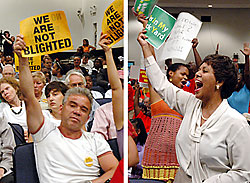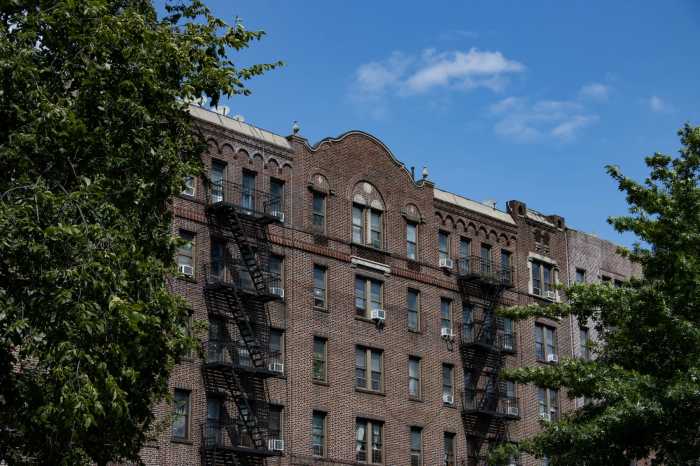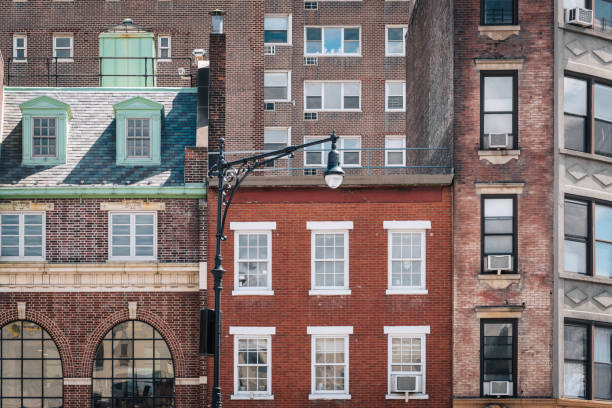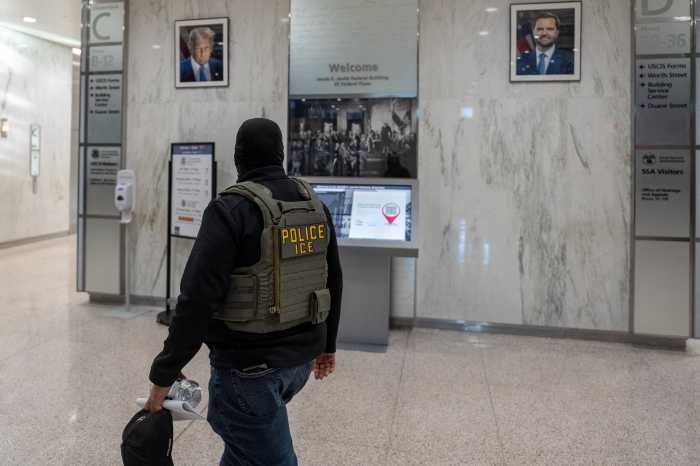Supporters and opponents of Bruce Ratner’s Atlantic Yards mega-development clashed loudly and repeatedly during Wednesday’s state hearing on the project — and in doing so put forward two distinct visions of Brooklyn’s future.
Seats were in short supply — and so was civility — at a NYC Technical College auditorium, as opponents of the project were roundly jeered by supporters, who, in turn, were booed by opponents.
Because the hearing’s moderator chose to alternate pro-Atlantic Yards speakers and anti-Yards speakers, the visceral chasm between the two sides was abundantly on display.
For every unemployed speaker begging the state to approve the project — whose backers predict will create “jobs in the community” — there was a seemingly more affluent activist ticking off the traffic, transit, open space, noise and pollution shortcomings of the project.
For every Rev. Herbert Daughtry, who got $50,000 from Ratner after he came out in support of the project, there was a Lee Solomon, a resident of Fort Greene, whose opposition to the project has not earned her a dime.
For every union ironworker making brownie points with his union to testify, there was a community activist hoping to testify quickly so she could save on babysitting.
The see-saw night started before the first speaker even approached the podium in the Klitgord Auditorium on Jay Street, Downtown, with a request from the moderator for civility — which was almost immediately ignored as Borough President Markowitz, who is the public official most identified by his outspoken support of the project, made the first speech.
Markowitz could barely be heard over the boos and cheers.
“Thank you very very much,” he said. “What you just heard was a Brooklyn cheer. It’s OK. I believe Atlantic Yards is the right project, at the right time, at the right place.”
His biggest applause line came when he said that Ratner would build his project with “100 percent union labor!”
But the cheering abruptly stopped when the Beep changed gears.
“This project needs to be reduced,” he said. “The Williamsburgh Savings Bank should remain Brooklyn’s tallest building! The height of [the 62-story] ‘Miss Brooklyn’ must be reduced. Next, build a school! And next, insure public safety. And get real about traffic and parking. Finally, make the open space accessible and integrated seamlessly into the neighborhood.”
After exceeding his allotted three minutes by at least two, he left the podium to a resounding chorus of boos, as project supporters felt betrayed and opponents felt that Markowitz’s concerns about the project came “too little, too late,” as one man yelled out.
As the second speaker of the night — state Sen. Marty Golden (R–Bay Ridge) — approached the podium, former Community Board 8 member Connie Lesold could not hold her tongue.
“It’s not right that he should speak,” she said as she was escorted out. “He’s from the far southern end of Brooklyn. His neighborhood hasn’t lost firehouses. This project is a giveaway to rich corporations!”
A dozen elected officials got to speak at the “public hearing” before the public itself, while hundreds of people waited their turn or, worse, waited outside just to get into the hearing.
Any politician who supported the project was cheered by scores of construction workers. Any who did not, was jeered by them. Supporters repeatedly derided opponents as white people out of touch with the needs of black Brooklyn.
Assemblyman Roger Green (D–Prospect Heights) stuck to that story line with a preacher’s cadence.
“I was born in Brooklyn and I was raised in Brooklyn,” he said. “Some of us were here before other people got here! Some of you have never been in the Fort Greene Houses. Some of you have never dared to go to the Farragut Houses. We will not be lectured to.”
Green spoke of the “conspiracy of silence” that deprives “the black man” of economic empowerment — but also said it was a “moral imperative” to bring the project’s scale down by 30 to 40 percent.
Next, Assemblywoman Joan Millman (D–Park Slope) complained that the Empire State Development Corporation released the project’s draft environmental impact statement and scheduled the public hearing during the summer, “when many people are on their vacation.”
She was hissed.
“Too many politicians in Brooklyn!” one man yelled.
The same man later cheered when another politician — this time, project supporter Assemblyman Karim Camera (D–Crown Heights) — mentioned high black unemployment.
“When people ask me, ‘How can you be for the project?’ I return the question, ‘How could I not be for this project?’ We need jobs. We need affordable housing. Do this for every black man who needs a job.”
Ratner claims there would be 1,500 construction jobs per year over the 10-year buildout of the project.
People speak
When the unelected masses got their turn to speak, the back-and-forth battle — complete with the breakdown in civility — continued.
A man from upstate Pleasantville spoke of traffic, the lack of greenspace and how historic restaurant Gage & Tollner was forced to close a few years back because Ratner “failed to live up to the promises he made at Metrotech.”
He was followed by Umar Jordan, who ridiculed his complaints.
“If you never been in the Marcy projects, you’re not from Brooklyn,” he said. “Go back to Pleasantville.”
Jordan, who lives in Bedford-Stuyvesant, added, “Black men and women are forced to rob because you won’t give them a job! You’re complaining about the height of the buildings and this and that. Well, welcome to the hood!”
Park Slope civics
Several members of the Park Slope Civic Council — speaking in three-minute allotments — read the group’s testimony into the record.
Lumi Rolley began by complaining that the hearing was scheduled “at a time when so many Brooklynites are squeezing in the last of their summer vacations.”
The group’s testimony focused on the DEIS’s failure to mitigate increased subway crowding, the loss of street parking and gridlock conditions.
Daughtry, whose House of the Lord Pentecostal Church is located in nearby Boerum Hill, followed the Civic Council’s by-the-book presentation with an impassioned sermon that argued that the area where Ratner wants to build was “written off” by they city for years.
“Nobody stepped up — but Forest City Ratner had a vision. So why are you holding this [project] against Forest City Ratner when development is going on all over Brooklyn with non-union work? And that bank building that you hold so sacred? That developer said there ain’t going to be affordable housing there! Protest against that!”
He was followed by Community Board 6 Chairman Jerry Armer, who also complained about the lack of time for a full analysis of the 2,000-page DEIS.
“This is a time when most people are away,” Armer said. “Even psychiatrists, which some of us sitting here may need when this is all over, are on vacation in August.”
Few traffic concerns
Before taking public testimony, ESDC officials offered brief presentations about the $4.2-billion project and its impacts.
Just three minutes was spent on traffic.
“The impacted locations are reduced substantially [by various mitigations], but there will still be what we would call non-mitigatable conditions,” said ESDC consultant Philip Habib. “There will be traffic congestion on Flatbush and Atlantic avenues and on Dean Street.”
Another ESDC official spoke of a “shortfall in the number of elementary and intermediate school seats” as a result of the project. “We considered that to be a significant adverse impact,” said the consultant.
By the time the ESDC presentations were done, 250 people had already registered for a three-minute timeslot. If each had been able to speak for the allotted time, the meeting would have taken 12-1/2 hours.
As it is, the scheduled four-hour hearing was extended to 11:30 pm, allowing slightly more than 100 people to speak.
The only moment of comic relief came from a speaker who identified himself only as “Mr. X” and was wearing mirrored sunglasses.
He compared the project to a drug deal and offered to put Ratner in “a tight-ass mini-skirt,” drawing laughter from both sides.
The remaining 200 or so speakers were told to submit their testimony in writing or attend a second hearing on Sept. 12 — but they were not promised a spot at the head of the line.
At the end of the long night, longtime opponent of the project, Daniel Goldstein of Develop Don’t Destroy Brooklyn, said he found the whole event a depressing “circus.”
“This hearing was meaningless,” he said.
“It became a shouting match rather than an analysis of the flawed DEIS. Ratner’s supporters don’t want to hear that opponents of Atlantic Yards do want affordable housing and jobs.”

























